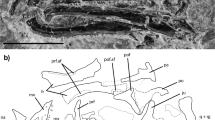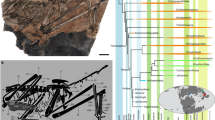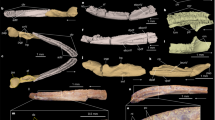Abstract
The origin of extant amphibians (Lissamphibia: frogs, salamanders and caecilians) is one of the most controversial questions in vertebrate evolution, owing to large morphological and temporal gaps in the fossil record1,2,3. Current discussions focus on three competing hypotheses: a monophyletic origin within either Temnospondyli4,5,6,7 or Lepospondyli8,9,10, or a polyphyletic origin with frogs and salamanders arising among temnospondyls and caecilians among the lepospondyls11,12,13,14,15,16. Recent molecular analyses are also controversial, with estimations for the batrachian (frog–salamander) divergence significantly older than the palaeontological evidence supports17,18. Here we report the discovery of an amphibamid temnospondyl from the Early Permian of Texas that bridges the gap between other Palaeozoic amphibians and the earliest known salientians19,20 and caudatans21 from the Mesozoic. The presence of a mosaic of salientian and caudatan characters in this small fossil makes it a key taxon close to the batrachian (frog and salamander) divergence. Phylogenetic analysis suggests that the batrachian divergence occurred in the Middle Permian, rather than the late Carboniferous as recently estimated using molecular clocks18,22, but the divergence with caecilians corresponds to the deep split between temnospondyls and lepospondyls, which is congruent with the molecular estimates.
This is a preview of subscription content, access via your institution
Access options
Subscribe to this journal
Receive 51 print issues and online access
$199.00 per year
only $3.90 per issue
Buy this article
- Purchase on Springer Link
- Instant access to full article PDF
Prices may be subject to local taxes which are calculated during checkout




Similar content being viewed by others
References
Milner, A. R. in The Phylogeny and Classification of the Tetrapods (ed. Benton, M. J.) Vol. 1, Amphibians, Reptiles, Birds 59–102 (Clarendon Press, Oxford, 1988)
Milner, A. R. The Paleozoic relatives of lissamphibians. Herpetol. Monogr. 7, 8–27 (1993)
Schoch, R. R. & Milner, A. R. in Recent Advances in the Origin and Early Radiation of Vertebrates (eds Arratia, G., Wilson, M. V. H. & Cloutier, R.) 345–377 (Verlag Dr. Fredrich Pfeil, München, 2004)
Bolt, J. R. in Origins of the Higher Groups of Tetrapods: Controversy and Consensus (eds Schultze, H.-P. & Trueb, L.) 194–222 (Comstock Publishing Associates, Ithaca, 1991)
Ruta, M. & Coates, M. I. Dates, nodes and character conflict: Addressing the lissamphibian origin problem. J. Syst. Palaeontol. 5, 69–122 (2007)
Ruta, M., Coates, M. I. & Quicke, D. L. Early tetrapod relationships revisited. Biol. Rev. 78, 251–345 (2003)
Trueb, L. & Cloutier, R. in Origins of the Higher Groups of Tetrapods: Controversy and Consensus (eds Schultze, H.-P. & Trueb, L.) 174–193 (Comstock Publishing Associates, Ithaca, 1991)
Laurin, M. & Reisz, R. R. in Amniote Origins (eds Sumida, S. S. & Martin, K. L. M.) 9–59 (Academic, San Diego, 1997)
Vallin, G. & Laurin, M. Cranial morphology and affinities of Microbrachis, and a reappraisal of the phylogeny and lifestyle of the first amphibians. J. Vertebr. Paleontol. 24, 56–72 (2004)
Laurin, M. The importance of global parsimony and historical bias in understanding tetrapod evolution. Part I. Systematics, middle ear evolution and jaw suspension. Ann. Sci. Nat. Paris 1, 1–42 (1998)
Anderson, J. S. The phylogenetic trunk: Maximal inclusion of taxa with missing data in an analysis of the Lepospondyli. Syst. Biol. 50, 170–193 (2001)
Anderson, J. S. in Major Transitions in Vertebrate Evolution (eds Anderson, J. S. & Sues, H.-D.) 182–227 (Indiana Univ. Press, Bloomington, 2007)
Carroll, R. L. in Amphibian Biology (eds Heatwole, H. & Carroll, R. L.) Vol. 4, Palaeontology: The Evolutionary History of Amphibians 1402–1411 (Surrey Beatty and Sons, Chipping Norton, Australia, 2000)
Carroll, R. L. The importance of branchiosaurs in determining the ancestry of the modern amphibian orders. Neues Jb. Geol. Palaontol. Abh. 232, 157–180 (2004)
Carroll, R. L. The Palaeozoic ancestry of salamanders, frogs and caecilians. Zool. J. Linn. Soc. 150 (s1). 1–140 (2007)
Carroll, R. L. & Currie, P. J. Microsaurs as possible apodan ancestors. Zool. J. Linn. Soc. 57, 229–247 (1975)
San Mauro, D. et al. Initial diversification of living amphibians predated the breakup of Pangaea. Am. Nat. 165, 590–599 (2005)
Zhang, P. et al. Mitogenomic perspectives on the origin and phylogeny of living amphibians. Syst. Biol. 54, 391–400 (2005)
Piveteau, J. Paléontologie de Madagascar. XXIII. Un Amphibien du Trias inferieur. Ann. Paléontol. 26, 135–177 (1937)
Rage, J.-C. & Roček, Z. Redescription of Triadobatrachus massinoti (Piveteau, 1936) an anuran amphibian from the Early Triassic. Palaeontographica A 206, 1–16 (1989)
Ivachnenko, M. F. Urodelians from the Triassic and Jurassic of Soviet Central Asia. Paleontol. J. 12, 362–368 (1978)
San Mauro, D. et al. Phylogeny of caecilian amphibians (Gymnophiona) based on complete mitochondrial genomes and nuclear RAG1. Mol. Phylogenet. Evol. 33, 413–427 (2004)
Duellman, W. E. & Trueb, L. Biology of Amphibians 2nd edn (The Johns Hopkins Univ. Press, Baltimore, 1994)
Trueb, L. in The Skull (eds Hanken, J. & Hall, B. K.) Vol. 2, Patterns of Structural and Systematic Diversity 255–343 (Univ. Chicago Press, Chicago, 1993),
Gao, K.-Q. & Shubin, N. H. Earliest known crown-group salamanders. Nature 422, 424–428 (2003)
Wang, Y. A new Mesozoic caudate (Liaoxitriton dauhugouensis sp. nov.) from Inner Mongolia, China. Chin. Sci. Bull. 49, 858–860 (2004)
Shubin, N. H. & Wake, D. B. in Amphibian Biology (eds Heatwole, H. & Davies, M.) Vol. 5, Osteology 1782–1808 (Surrey Beatty and Sons, Chipping Norton, Australia, 2003)
Fröbisch, N. B., Carroll, R. L. & Schoch, R. R. Limb ossification in the Paleozoic branchiosaurid Apateon (Temnospondyli) and the early evolution of preaxial dominance in tetrapod limb development. Evol. Dev. 9, 69–75 (2007)
Anderson, J. S. et al. Georgenthalia clavinasica, a new genus and species of dissorophoid temnospondyl from the Early Permian of Germany, and the relationships of the Family Amphibamidae. J. Vertebr. Paleontol. 28, 61–75 (2008)
Lee, M. S. Y. & Anderson, J. S. Molecular clocks and the origin(s) of modern amphibians. Mol. Phylogenet. Evol. 40, 635–639 (2006)
Acknowledgements
We thank M. Carrano, D. Chaney, B. DiMichele and P. Kroehler of the USNM for information and photographs of the discovery locality and for access to the specimen. E. Rega transported the specimen from Washington DC to Los Angeles. We thank P. Janvier and le Museum National d’Histoire Naturelle in Paris for support while one of us (J.S.A.) studied the holotype of Triadobatrachus. The research was further supported by Natural Science and Engineering Research Council of Canada Discovery Grants to R.R.R. and J.S.A.
Author Contributions J.S.A. contributed to project planning, figure preparation, anatomical analysis, phylogenetic analysis, manuscript preparation and financial support for study; R.R.R. to phylogenetic analysis, manuscript preparation and financial support; D.S. to specimen preparation, figure preparation, anatomical analysis and manuscript preparation; N.B.F. to anatomical analysis, phylogenetic analysis and manuscript preparation; and S.S.S. to project initiation and manuscript preparation.
Author information
Authors and Affiliations
Corresponding author
Supplementary information
Supplementary information
The file contains Supplementary Data including the data matrix in Nexsus format saved in Rich Text. (RTF 44 kb)
Rights and permissions
About this article
Cite this article
Anderson, J., Reisz, R., Scott, D. et al. A stem batrachian from the Early Permian of Texas and the origin of frogs and salamanders. Nature 453, 515–518 (2008). https://doi.org/10.1038/nature06865
Received:
Accepted:
Issue Date:
DOI: https://doi.org/10.1038/nature06865
This article is cited by
-
Triassic stem caecilian supports dissorophoid origin of living amphibians
Nature (2023)
-
Carboniferous–Permian climate change constrained early land vertebrate radiations
Nature Ecology & Evolution (2019)
-
New insights into the evolution of temnospondyls
Journal of Iberian Geology (2019)
-
Hidden morphological diversity among early tetrapods
Nature (2017)
-
ZD7288, a blocker of the HCN channel family, increases doubling time of mouse embryonic stem cells and modulates differentiation outcomes in a context-dependent manner
SpringerPlus (2016)
Comments
By submitting a comment you agree to abide by our Terms and Community Guidelines. If you find something abusive or that does not comply with our terms or guidelines please flag it as inappropriate.



